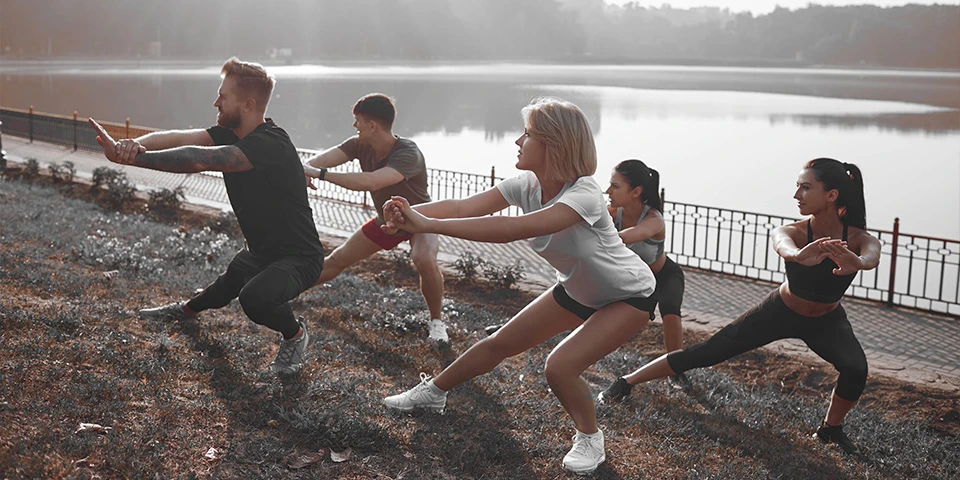We all understand the importance of keeping our clients engaged and motivated, especially during the colder months. Training outdoors has been a cornerstone of fitness for many, but recent studies have shed light on the unique benefits that may not be as widely recognised. Here, we explore these benefits and provide strategies for training clients outdoors in the cold weather, backed by the latest scientific research.
The Unseen Advantages of Outdoor Fitness Training
Recent studies have highlighted the psychological benefits of outdoor exercise that complement the well-known physical advantages. For instance, a study by Feng et al. (2021) on the systematisation of sports students in scientific exercise training revealed that a digital fitness teaching system could significantly improve students’ scientific exercise ability, not just in physical terms but also in promoting mental health (Feng, 2021). This suggests that the integration of technology and outdoor exercise can lead to improved engagement and enjoyment, crucial for mental and emotional health.
Moreover, research on the combined use of health-improving fitness methods indicated that varied outdoor fitness activities could have a broader impact on overall wellbeing, including psychological aspects (Steinmetz-Wood et al., 2023). These findings underscore the importance of diversifying outdoor fitness routines to enhance motivation and psychological wellbeing.

Embracing the Cold: Training in Winter
Training outdoors in winter presents unique challenges. The cold weather can be a significant barrier to physical activity, as noted by Gallagher et al. (2023), who found that motivation and cold weather were among the top obstacles to exercise (Gallagher et al., 2023). However, with the right approach, fitness professionals can turn these challenges into opportunities for their clients.
Tips and Tricks for Winter Training
- Layer Up Smartly: Encourage clients to dress in layers that can be removed as they warm up during their workout. The base layer should be moisture-wicking, the middle layer insulating, and the outer layer wind and water-resistant.
- Warm-Up Indoors: Begin the session with an indoor warm-up to raise the body temperature before heading outside. This can reduce the shock of the cold and make the transition more comfortable.
- Use the Environment: Incorporate natural elements such as park benches for step-ups or hills for sprints. This not only adds variety but also takes advantage of the outdoor setting.
- Short and Intense: Opt for shorter, high-intensity sessions to keep the body temperature up and the session exciting. This can also be more appealing than a long, cold workout.
- Stay Hydrated: Cold weather can mask sweat loss. Remind clients to drink water before, during, and after their workout.
- Emphasise the Scenery: Use the natural beauty of outdoor settings to enhance the psychological benefits of exercise. A change of scenery can be a powerful motivator.
- Safety First: Ensure that the training area is safe, especially in terms of footing to prevent slips and falls on icy surfaces.
- Social Support: Create group training sessions or challenges to foster a sense of community and accountability, which can be especially motivating during the winter months.
Outdoor training offers a multitude of benefits that extend beyond physical health, touching on mental and emotional wellbeing. By employing strategic methods to overcome the challenges of cold weather, fitness professionals can provide their clients with an invigorating and effective workout experience.
References:
- Feng, Z.-X. (2021). Research on the Systematisation of Sports Students in Scientific Exercise Training. Journal of Physical Education and Sport, 21(4), 2093-2099. Click here to review the full research article
- Gallagher, J., Bayman, E. O., Cadmus-Bertram, L. A., Jenkins, N. D. M., Pearlman, A., Whitaker, K. M., & Carr, L. J. (2023). Physical Activity Among Rural Men: Barriers and Preferences. Preventing Chronic Disease, 20. Click here to review the full research article
- Steinmetz-Wood, S., Loomba, K., Hitt, J., Kennedy, A., Gilbert, M. P., & Barrett, K. (2023). SAT444 Perceptions Of Endocrine Clinicians On Climate Change And Health. Journal of the Endocrine Society, 7(10). Click here to review the full research article
Master the Art of Outdoor Workout Programming
Elevate your training expertise with our Outdoor Fitness course, designed exclusively for fitness professionals who aspire to expand their programming skills and master the art of delivering invigorating outdoor workouts. This comprehensive course is your gateway to crafting dynamic, effective, and enjoyable fitness experiences in the great outdoors. Whether it’s a bustling city park or the serene countryside, you’ll learn to utilise the environment to its fullest potential, ensuring your clients stay motivated, engaged, and eager for more. As a standout feature of our esteemed TRAINFITNESS Specialist & Master Personal Training Diplomas, this course not only broadens your professional repertoire but also distinguishes you in the fitness industry as a versatile trainer capable of adapting to any setting. Join us to unlock the secrets of outdoor training and watch your business thrive under the open sky!
Outdoor Fitness Course – In-Person, Live-Virtual, Distance Study

